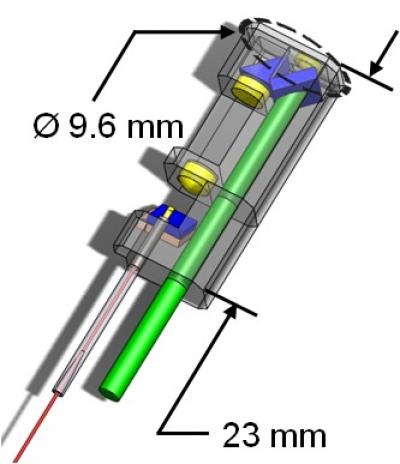A small, flexible endoscopic medical device equipped to a femtosecond laser "scalpel" has been designed by the research team at the University of Texas, Austin. This device targets only the diseased or damaged tissue without causing any harm to the healthy cells. This research will be presented during CLEO: 2012, a Conference on Lasers and Electro Optics, scheduled from May 6-11 in San Jose, Calif.
 The packaged endoscope is overlaid with the optical system. The circumference is 9.6 millimeters and the length is 23 millimeters. Credit: Ben-Yakar Group, University of Texas at Austin
The packaged endoscope is overlaid with the optical system. The circumference is 9.6 millimeters and the length is 23 millimeters. Credit: Ben-Yakar Group, University of Texas at Austin
It is known that when traditional scalpel or surgical lasers are used for medical operations, especially on delicate areas like the digestive tract, brain, or throat, it sometimes removes healthy tissues causing collateral damage.
Designed with off-the-shelf parts, this device consists of a laser that can generate pulses of light up to 200 fs in duration. Although these bursts are powerful, they are short-lived and do not affect the surrounding tissue. Incorporated to a mini-microscope, the laser offers precision control for delicate surgeries. Based on two-photon fluorescence imaging technique and using the microscope with high penetration IR light, the surgeons can perform on individual cells or cell nuclei.
The entire endoscope probe package measures 23 mm long and 9.6 mm in circumference, compatible with large endoscopes.
According to Adela Ben-Yakar from the University of Texas, the new system, despite its small size 5x less than the first prototype, shows 20 % increase in imaging resolution. The optics includes three parts such as a 750- µm MEMS (micro-electro-mechanical system) scanning mirror, a specialized fiber, through which the ultrashort laser pulses from the laser is delivered to the microscope, and commercial lenses. In order to maintain the alignment of optical components, the team developed a minute case based on 3-D printing. Here, digital file is used to create solid objects by accumulating successive layers of material.
Besides eye surgery, tabletop femtosecond lasers are used for removing small tumors in the spinal cord or for repairing the vocal cords.